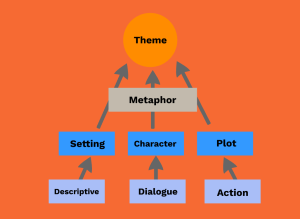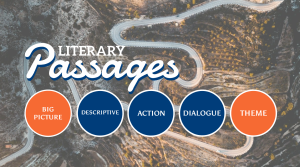4 Passages
Learning Objectives
-
Examine different types of literary passages and consider how their purposes might serve the author’s goals.
-
Cite specific textual evidence to support inferences and conclusions drawn from the text.
Chapter & Discussion
This chapter includes a presentation that can be navigated in a classroom setting or independently. You can access the presentation via the link below.
Literary Passages: A Paragraph, A Purpose
Work through the different sections of the chapter and discuss ideas and topics as they arise. If you’re working independently, take notes instead. Notes and active discussion will be helpful in navigating this week’s assignments.
Big Picture: All Roads (Still) Lead to Theme
When an author tells a story, the big goal is to communicate big ideas, or themes.
Last lesson, we learned that setting, character, and plot can help the author communicate these themes by being metaphors for them.
Today, we’ll talk about how the different types of passages can do the same.
Passages
Passages are the actual paragraphs in a story. When you write a paragraph, it’s going to have a purpose. That can be one of the following:
It can describe something- this is called a descriptive passage
It can tell us what happens- this is called an action passage
It can tell us what people say- this is called a dialogue passage
Descriptive Passages
These passages fill in details about the world the characters live in. They can:
Describe a place, time, and the circumstances that characters face
Build understanding of the world
Help establish mood and tone
Provide realism
These passages help the author establish the setting.
From Tuck Everlasting by Natalie Babbit
The road that led to Treegap had been trod out long
before by a herd of cows who were, to say the least,
relaxed. It wandered along in curves and easy angles,
swayed off and up in a pleasant tangent to the top of a
small hill, ambled down again between fringes of
bee-hung clover, and then cut sidewise across a meadow.
Here its edges blurred. It widened and seemed to pause,
suggesting tranquil bovine picnics: slow chewing and
thoughtful contemplation of the infinite. And then it went
on again and came at last to the wood. But on reaching
the shadows of the first trees, it veered sharply, swung out
in a wide arc as if, for the first time, it had reason to think
where it was going, and passed around.
Action Passages
These tell us what happens. They can:
Describe intense actions like a chase or a fight, but also more subtle actions
Show us the choices that characters make, and help us see the consequences of those choices
These passages help the author build the plot.

Dialogue Passages
These tell us what people say. They can:
Help us understand the intentions and obstacles of the characters
Develop relationships
Advance character development
These passages help the author build and develop the characters.
From Tuck Everlasting by Natalie Babbit
“Nothing’s going to change.”
“You tell me that every day,” said Tuck, turning away
from her onto his side. “Anyways, I can’t help what I
dream.”
“Maybe not,” said Mae. “But, all the same, you
should’ve got used to things by now.”
Tuck groaned. “I’m going back to sleep,” he said.
“Not me,” said Mae. “I’m going to take the horse and go
down to the wood to meet them.”
“Meet who?”
“The boys, Tuck! Our sons. I’m going to ride down to
meet them.”
“Better not do that,” said Tuck.
“I know,” said Mae, “but I just can’t wait to see them.
Anyways, it’s ten years since I went to Treegap. No one’ll
remember me. I’ll ride in at sunset, just to the wood. I
won’t go into the village. But, even if someone did see me,
they won’t remember. They never did before, now, did
they?”
“Suit yourself, then,” said Tuck into his pillow. “I’m going
back to sleep.”
Back to Theme
How to passages help authors communicate ideas?
Passages are the primary way that authors share the setting, characters, and plot.
These elements are already helping author’s communicate themes, because they serve as metaphors for the author’s ideas.

Assigned Reading
Here are this week’s readings. Additionally, please read for your own personal enjoyment for 1/2 hour each day. This will be called your “Reading Zone” reading and it will coincide with many upcoming activities.
The Hobbit: Chapter One- An Unexpected Journey by J.R.R. Tolkien (via The New York Times) (Audiobook via Journey to Arda)
Note: You don’t have to complete this chapter. Just read enough to get a feel for the writing style.
Quick Reflection: What type of passage does this author favor? How does it assist with their storytelling?
Practice Set: Passages
Click here to complete a practice set that explores concepts from the chapter.
These practice sets are designed to resemble the types of questions you’ll encounter on the GED RLA test. In this case, I am including a full novel chapter so that the reading can be engaging and so that you can have meaningful practice in the skill of close reading.
All of the practice sets in the Literature Unit will take on this format so that you can engage in enough practice to level up your reading skills while having access to literature that’s worth your time.
Assignment: Add A Passage (150 Words)
Pick one of the following types of passage:
-
Descriptive
-
Action
-
Dialogue
Predict what will happen next in your Reading Zone book. Write a 150-word passage that will satisfy your prediction. Use the passage type you selected and try to mimic the style of your author.
Assignment: Reading Zone Response (250 Words)
For Reading Zone, you must find a novel that is interesting to you and enjoyable to read. If you need help finding a Reading Zone book, please ask. Please read your Reading Zone book for a half-hour each day. On class days, there will be time in class dedicated to reading.
Create a response to this week’s reading that addresses the following prompts:
-
In one paragraph, summarize what you’ve read this week
-
In a second paragraph, describe a passage from your reading this week that you found engaging. What type of passage was it? What do you think were the author’s intentions with this passage? Did they succeed?



